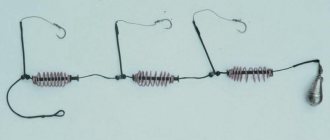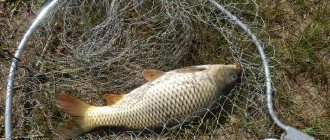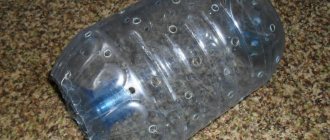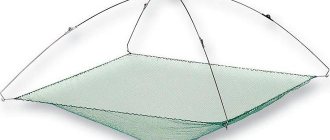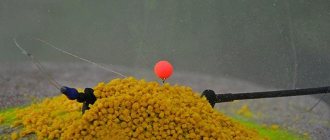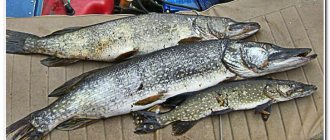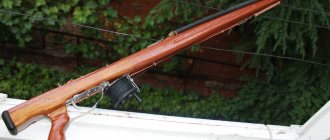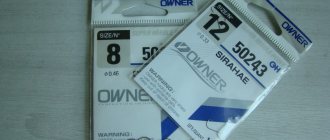The top is a fishing gear of the straining type, installed at the bottom of the reservoir. In fishing practice, there are several types and methods of fishing with tops:
- with and without bait;
- in summer and spring during spawning.
The first method is very simple: the top is installed at the bottom between stones or in thick algae. You can put bait inside the top. The fish follows the smell of bait and enters the hole in the chamber. The entrance hole is made at a special angle, so the likelihood of it coming back is very small.
The second is based on the fact that many fish need additional accumulation during spawning and look for hard objects to rub against them, squeezing out eggs and milk.
To achieve a good result, you need to know the body of water chosen for fishing, the behavior and habits of the fished objects. For example, fish such as pike, crucian carp, and bream spawn in shallow water and give themselves away with noisy splashes. Finding the spawning grounds of tench, lamprey and perch is much more difficult.
Fishing classic Leonid Sabaneev advised in such cases to create artificial spawning grounds from a pile of stones or branches and after that install a top in it.
Many supporters of sport fishing have the opinion that fishing with nets during spawning is detrimental to fish reproduction. On this issue, you can quote an excerpt from the book by L.P. Sabaneev “Fishes of Russia. Life and fishing of our freshwater fish": "...Fishing during spawning is usually considered harmful for reproduction, but this opinion in reality - in practice - is not always true, and I think that there is no complete reason to unconditionally prohibit fishing during spawning. Only destructive fishing methods are always harmful - in spring and winter - when the fish are caught completely - adults along with small things and in cases where a significant part of the fish die simply in vain. Fish does not hatch children, does not feed them, the number of eggs is considered to be in the thousands and tens of thousands, and therefore protecting fish in the spring cannot have the same meaning as protecting four-legged and feathered game. The whole point is that some of the eggs are safely swept out, and therefore fishing before spawning is more harmful than after. Some fishing methods even have a positive effect on increasing the number of fish. So, for example, fishing with various top-shaped gear. Wooden tops themselves even act as bait for fish and create an artificial spawning ground, and a mass of young fish hatch from the eggs stuck to the walls of the top.”
What else can I add here? This is a completely comprehensive and reasoned opinion. However, let's get back to fishing with tops.
Fishing with tops on small rivers and streams has its own characteristics. The flood there is very rough, but the water subsides quickly, and it is very difficult for fish to find shores suitable for spawning, covered with vegetation and flooded with water. Very often, roach and pike spawn along washed-out steep banks, on the roots of trees and bushes hanging into the water. Such places are very convenient for installing the top - the tackle is not located close to the shore, but actually under it, and it is almost impossible to discover it by accident.
Another method of fishing in the spring is that the top does not attract fish as a convenient object for squeezing out eggs and milk, but stands in an open state in the mud of the fish migration.
The fish are very successfully caught where the river or stream narrows sharply. It is necessary to ensure that the top is not carried away by the current; to do this, the top is tied to a tree or to a stake driven into the bottom.
Double-entry tops are especially successful in catching. They can be aimed at both rising and falling fish.
Fishing with tops in the summer is usually carried out using a variety of baits.
If you choose a top with a minimum mesh mesh, then the small fish caught inside serves as bait for predators such as burbot, perch and pike. If you fish in a fast current, the bread bait is ineffective because it is quickly washed out by water. In stagnant water and low currents, if the top is checked less than once every two days, the bread sours and, on the contrary, scares away the fish. The most traditional and popular is the use of cake; in its absence, pieces of foam rubber soaked in oil.
In open and clean places, placing tops, even with bait, is not effective. The best places are dense water thickets, washed-out banks, narrow places in rivers and streams, and passages between boulders. All types of tops and hems can be purchased in our Petrokanat online store.
How to make a fishing tackle with your own hands
Tackle for passive fishing - a fishing top - can be made with your own hands from any suitable material. You can quickly make it if you have a ready-made container for the case. When surviving in extreme conditions, it makes sense to spend a little time and make a trap using traditional technology.
What is a fishing top?
The muzzle, venter, or top is a trap with a funnel-shaped entrance. A fish interested in the bait swims through a gradually narrowing tunnel and gets inside the body, where the bait lies. When trying to leave the container, the fish is no longer able to find the hole through which it entered.
When removing the tackle from the water, the fisherman can get the catch through another hole, which remains closed while the tackle is working. If the homemade top is made from a ready-made container (can, plastic bottle), then it is advisable to provide a funnel attachment that will make it easy to remove it when taking out the catch.
How to do it yourself?
Traditionally, willow or other thin and flexible branches were used to make the top. To weave a funnel, a ring with a diameter of 5-7 cm was made, on which a vine for the base was secured.
The base was braided with thinner strands, and it was given the shape of a funnel, expanding from the ring.
Having made an entrance about 20-25 cm long, they began to weave the expanded upper part of the muzzle, spreading the warp rods to the sides and gradually bending them down.
The entrance funnel then ends up inside the wicker vessel, which again begins to narrow towards the top. In a simple method, the ends of the unbraided rods can be tied with a strip of strong bark or rope, closing the hole.
In a more complex version, a ring of larger diameter was placed on this hole, and a lid made from a circle of thick bark or woven from a vine was attached to it.
Similar designs are still woven in villages using wire.
From a plastic bottle
At a picnic by a pond, the muzzle can be easily made from scrap material using a water or beer container. The amount of fish that can be caught in 1 cast and the size of the crucian carp depend on its volume.
Cut off the neck of the bottle and part of the body at about 1/3 of its height. If necessary, you can also remove the screw part under the cover to slightly enlarge the hole. In 5-liter cylinders this can no longer be done.
Turn the cut part of the container over and place the neck inside the container. Connect the edges of the parts with wire. The fastening must be detachable so that the neck can be removed and the fish can be taken out of the trap.
It is recommended to make several small holes in the walls of the bottle so that it is better filled with water when throwing gear. To lift the top from the pond, you need to tie a long, strong rope to the container.
From the air filter
You will need a large filter from a truck (most often they take an air filter from KAMAZ). Remove all filling from the mesh body. A cylindrical metal grid is well suited for quickly making a top with your own hands:
- cut out and fasten at one end a dense, blind cover made of tin or plastic, plywood, etc.;
- make a funnel for entering the trap from flexible sheet material;
- strengthen the funnel with the narrow end inside the mesh body;
- tie a rope.
With metal frame
Frame products will require the use of thick steel wire and material to cover the frame. Most often, nylon or plastic mesh with a fine mesh is used as covering. You can make a top on a frame with 1 or 2 funnel-shaped entrances:
- made of steel wire several rings of the same size. Their diameter is chosen arbitrarily, but to catch large fish it is better to make the muzzle at least 30 cm wide. The length of the product depends on the number of rings; you can make 3-5 frame rings.
- Make 1-2 small rings for the entrances from the same wire. Their diameter can vary between 5-10 cm, depending on the size of the desired prey.
- Wrap the net around a large ring, leaving a free edge of about 20 cm in length. Tie the net to the ring with a slight overlap at the junction of the side edges. After 20-30 cm, also tie another 1-3 rings, and secure the last one at a distance of 20 cm from the edge of the mesh. You should get a soft cylinder with a loose mesh on the end sides.
- Shape the edges of the net into a cone shape, laying several folds, and attach small rings to the edges.
- Bend the tapered ends inside the body. To prevent the fish from swimming through the trap in a straight line, the entrances are shifted to the opposite sides of the venter, secured with leashes made of wire or fishing line.
If they make a top with 1 entrance, then the other end can be tied tightly so that the fish does not escape through it. The same principle applies to collecting crayfish, but making one side flat so that it fits better on the ground. The frame wire can be replaced with a plastic tube rolled into circles of the desired diameter.
Made from metal mesh
Another way to make a fishing top is to use a rigid galvanized mesh. From it you need to cut a rectangle, the width of which will be equal to the length of the future product. The length of the workpiece is selected so that it can be rolled into a cylinder with a diameter of about 30 cm.
top body and connect the side seam using wire. Cut out a funnel from the same mesh, roll it up and secure it to the end of the mesh cylinder. The other end of the body is equipped with a lid that can be opened to remove the catch. Attach the rope.
Top fishing methods
Fishing for top fish can be done with or without bait. Fish can be attracted by the smell of food or the structure itself (during the spawning period). But for successful fishing you need to know how and when it is better to catch crayfish or crucian carp.
With bait
The feeding instinct forces the fish to dig into the most inconvenient places if it expects to get to the food.
Lures that many breeds find attractive are placed in the muzzle: bread or dough flavored with vegetable oil, and sometimes with odorous substances (anise drops, perfume, valerian tincture, etc.).
Potato peels, egg shells, and dough are suitable for catching crucian carp. In addition to crucian carp, minnows and minnows are used for such bait.
They are caught with bait in the summer, throwing their muzzles into the shady corners of the reservoir. It is advisable to drown the top where the strip of coastal underwater vegetation begins.
If it is possible to observe the reservoir during the morning and evening feeding of the fish, then the fisherman will be able to determine a more accurate location for casting the tackle: the tip is placed where the fish were playing.
You need to check the tackle several times a day, removing the caught prey from it.
Without using bait
Sometimes catching tops is possible even without using bait. The method without bait is used in the spring, when the fish goes to spawn and may find that such a convenient place is suitable for spawning.
Different breeds of fish that prefer to spawn in thickets of plants can get into the snout at this time. The trap is placed where a concentration of crucian carp, bream, and ide is found.
The spawning site is easy to determine by splashes of water.
On rapids, in small streams, venters are placed in a narrowing channel. Passing along the river, the fish is forced inside and cannot get out of the trap. With a little practice, you can determine the best way to place the top on the river: on the current or closer to the spawning grounds.
Disadvantages of top
Homemade fish traps (fish traps) are quite bulky structures. The folding version can only be made from wire rings or spirals covered with mesh, but other methods do not have this property.
The disadvantages include the difficulty of catching large fish.
Source: https://ribaku.info/snasti/versha-svoimi-rukami
Another way to make a trap
According to experienced fishermen, it is much easier to make a trap using ready-made elements for the trap - a branded fishing net and thick metal wire. When choosing a net, you should consider the likely size of the fish being caught.
This is interesting: How to make gear for pelengas and master fishing techniques
For hunting large fish, a net with a mesh size of 5-6 cm is suitable. The craftsman needs to make three rings from wire.
Expert opinion
Smirnov Alexander Stanislavovich
Wilderness survival instructor. More than 15 years of teaching experience
They will be used as a frame for a homemade top. When making a neck for the upper part, it is also advisable to make one ring.
According to experienced craftsmen, there are no clear instructions on how many rings will be needed to top them.
Each fisherman can determine their number at his own discretion. This can be done by eye, taking into account the overall length of the entire structure.
After the rings are made, they need to be sheathed with a net. Then the wire ring, which will be used as the bottom for the bait, is connected using cords to the neck of the top.
After this, the homemade top is installed on the bottom of the reservoir.
Versha
- This is a trap, which is a metal frame covered with a knotted frame. As soon as they call the top: venter, yater, muzzle, merega, kubar, dive. It is installed at the bottom of the reservoir in the path of fish movement and “catches” without the direct presence of the fisherman.
Just like any trap, the top works better with bait. Put complementary foods inside the chamber! The fish will follow the smell and enter the chamber opening. The design of the top is made in such a way that once it passes through the entrance hole, it is almost impossible for the fish to get back out. By equipping the top with bait, you will have a high chance of catching a pike or other predator that hunts for fry in coastal waters.
The top is a completely autonomous fishing gear. All you need to do is set the top close to the shore and put the bait inside. After some time, you check the trap and take out a fresh catch - live fish. Select the required top
You can click the
Buy .
From a plastic bottle
This method is quite popular. To make the tackle you need to prepare a plastic bottle. At the same time, you need to understand that the size of the hole through which the fish will enter will limit its size. If you want to catch larger fish, you need to take a larger vessel.
So, first you need to cut off the upper, cone-shaped part where the bottle has a hole. It needs to be expanded to the desired size. The loan with the cone inside is sewn to the edges of the bottle. Often a large drinking water bottle is used for this purpose. It should be noted that fish caught inside will need to be removed somehow.
One-year and two-year-old willow shoots - long, thin, flexible - are suitable for weaving vine traps. It also makes sense to cut thicker rods in small quantities - they will be useful for making the longitudinal ribs of the trap frame, and if the tackle is supposed to be round or oval, you need to stock up on several branches, not rods, but rather branches about 2 cm thick, for making hoops.
In northwestern Russia, we most often use redwood for weaving, scientifically called purple willow. In other regions, weavers prepare twigs of other varieties of willow - the willow family is very numerous, and about 160 species belonging to it grow in Russia.
The main thing is that the shoots are not short, knotty, or have shoots. The best twigs are considered to be those growing directly from the ground or from a low-lying branch; such twigs are very long, flexible and almost without leaves.
The twigs are cut off either in the spring, before the buds swell, or in the fall, when the leaves have already fallen off. Before you start cutting the rods, they are tested for flexibility by wrapping them around your finger. If the rod does not break, the material is suitable for use.
You should always stock up on material - a decent-sized trap requires several hundred rods to make, and they often break during work and go to waste.
At home, cut rods are sorted by thickness: thick ones will be used to make the wide part of the muzzle, and thin ones will be used for the shank and neck.
Under no circumstances should the rods be cleared of bark, although this is the operation mentioned in many manuals on decorative weaving. The point is not only that the light twigs, cleared of bark, are too noticeable in the water (over time they will darken and this defect will disappear by itself).
The main thing is that willow bark contains tannins, which greatly prevent wood from rotting - a trap made of unsanded twigs will last twice as long.

